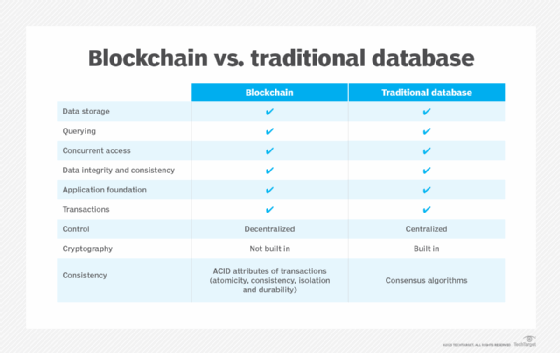Blockchain Vs. database: Similarities, differences explained
[gpt3]rewrite
Blockchain and database technologies have many similarities and differences and are often compared to each other.
While the two technologies can serve similar purposes and be used together, they work in different ways. Understanding how blockchain and traditional database technologies work is critical to understanding where each technology can best be used in an application deployment or service.
What is a blockchain?
A blockchain is a decentralized, distributed database or ledger that is replicated and synchronized across computers in a network. Since each computer has a current copy of the ledger, the data is not vulnerable to a single point of failure. The copies are updated and validated in parallel by each participant.
Blockchain is a type of distributed ledger technology. It is designed to allow the secure recording of data in an immutable ledger, meaning that the data cannot theoretically be tampered with. Data is hashed cryptographically — that is, converted into strings of characters that cannot be easily decoded — and stored in blocks that are linked together, which is where blockchain gets its name.
Blockchain is not only used to store data. It also enables cryptocurrencies such as Bitcoin and Ethereum’s Ether. Blockchain technologies are also fundamental to Web 3.0 (also known as Web3) platforms, which often also rely on cryptocurrency and are touted as the building blocks of the next generation of the web. Blockchain enables the decentralized, peer-to-peer network approach essential to the operation of Web 3.0 technologies, including decentralized finance, non-fungible tokens, and distributed applications.
What is a database?
A database is software used to store and retrieve data.
There are many types of databases, including relational databases, which use rows and columns to organize data. Relational databases often rely on SQL to allow users to search for and access data. Among the most widespread relational databases are Oracle Database, Microsoft SQL Server and open source PostgreSQL.
Another common type of database is the NoSQL database, which is not actually a single technology, but can refer to non-relational document databases and graph databases. Common distributed NoSQL databases include Couchbase, MongoDB, and Neo4j.
Databases can serve as a system of record for financial transactions, product catalogs, healthcare systems, and supply chain management, among many business uses. Databases are also often part of the application stack for applications such as data analytics, ERP, mobile applications and content management systems.
The difference between blockchain and database technology
The two technologies share many overlapping functions and can be used for some of the same applications.
Among the similarities between blockchain and databases are the following:
- Data storage. Both allow users to store information.
- Data requests. The ability to search for data is common to both technologies.
- Simultaneity. The ability for multiple users to execute queries simultaneously is a core feature.
- Integrity and consistency. A characteristic of both technologies is the focus on maintaining data integrity and consistency.
- Run applications. Applications of all types use both blockchain and databases as a basis.
- Activation of transactions. Both blockchain and database technologies are often used to enable transactions, such as product purchases.
Nevertheless, there are important differences between the typical blockchain distribution and a traditional database.
Most databases are controlled and managed from a central location, while these functions are decentralized and distributed in blockchain.
While a traditional database may use encryption for security, it is not an integral part of the database or included by default. In contrast, a blockchain by definition includes a cryptographic hash. Cryptography is included by default and is what makes the blockchain immutable.
Modern relational databases use four transaction attributes—atomicity, consistency, isolation, and durability (ACID)—that help ensure that transactions execute correctly. With blockchain, consistency comes from the consensus algorithms that synchronize data across the nodes of a chain.

Advantages of using blockchain
Blockchain potentially offers significant benefits to application developers and users. Among the benefits are the following:
- Web 3.0 integration. As a fundamental element of Web 3.0, blockchain enables developers to build the decentralized applications expected to be a crucial aspect of Web 3.0.
- Immutable data. Each transaction in a blockchain is cryptographically hashed to prevent tampering.
- Privacy. Blockchain helps improve privacy by not requiring users to authenticate with anything more than a combination of public and private keys.
- Fault tolerance. The distributed structure of most blockchains minimizes the risk of a single point of failure.
Advantages of using traditional databases
Traditional databases are a standard technology that has been around for decades and have many advantages, including the following:
- Familiar. Developers and users are probably far more familiar with deploying and using a traditional database. It is a proven technology that has stood the test of time.
- Compatibility. Traditional databases are compatible with a huge variety of enterprise and consumer applications developed over decades.
- Skills. Traditional database technology has long been used in critical business processes, and the talent pool of trained database administrators is large.
- SQL queries. SQL provides developers, data analysts, and database administrators with a comprehensive set of capabilities for accessing, querying, and manipulating data.
Blockchain tables integrate blockchain with traditional databases
Is blockchain better than a traditional database? The question requires a nuanced answer, partly because it is not an either-or choice.
Blockchain is considered by some observers to be a type of distributed database, much like a document database is a type of NoSQL database. For organizations looking to deploy a distributed database instead of a traditional one, blockchain is a highly secure and encrypted alternative.
To make matters even more interesting, traditional databases can also integrate blockchain. An increasingly popular approach to database product development is to have what is known as a multi-model database. In the multi-model approach, relational, document, graph database and other models – including blockchain – are all available in a single database.
Traditional database vendor Oracle, for example, began integrating blockchain into its multi-model approach with the Oracle Database 21c update released in January 2021. With the Oracle approach, a blockchain table — an immutable, cryptographically secured set of data stored in tabular format — – is available. It’s not the same completely decentralized approach that usually characterizes blockchain, but it’s blockchain nonetheless.
Oracle is not the only traditional database vendor to embrace some of the concepts of blockchain. Microsoft introduced a distributed ledger with blockchain capabilities in its Azure SQL database in May 2021.
[gpt3]

